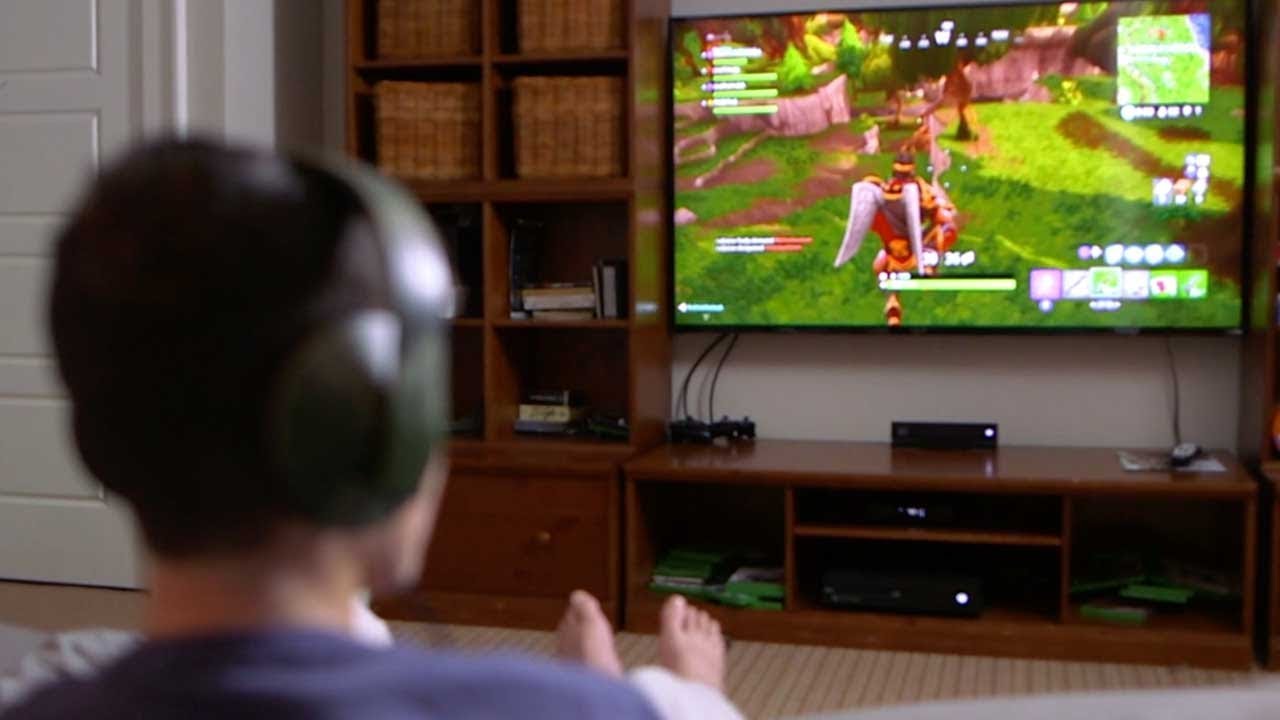
Scroll through any parenting forum or news feed, and you’ll likely encounter worried headlines about popular video games. Titles like Roblox Fortnite Gaming Addication kids’ screen time, leading many parents to ask the anxious question: Are these games actually melting my child’s brain? The flashing screens, intense focus, and hours spent in virtual worlds can seem alarming, fueling fears about attention spans, addiction, and long-term cognitive effects. What’s the shocking truth about gaming addiction in 2025?
The truth, as is often the case, is more complex than a simple “yes” or “no.” While the idea of brains literally “melting” is hyperbole, there are valid concerns about excessive gaming and the potential for addiction, especially with highly engaging platforms like Roblox and Fortnite. However, research also points to potential cognitive and social benefits. This guide aims to cut through the panic, presenting a balanced view based on current research and expert opinions (as of April 2025), exploring the real risks, potential rewards, signs of genuine addiction, and practical strategies for parents navigating this pixelated landscape.
The Magnetic Pull: Why Kids Love Roblox & Fortnite
Before exploring risks and benefits, it’s crucial to understand why these platforms are so captivating for children and adolescents:
- Social Connection: These games are virtual hangouts. Kids connect, chat, and collaborate with friends (and sometimes strangers), fulfilling a fundamental need for social interaction, especially as they grow more independent. (Source: Cleveland Clinic Health Essentials)
- Creativity & Freedom (Roblox): Roblox provides a vast “metaverse” where users can create their own games and experiences, offering unparalleled opportunities for imagination and digital creation.1 (Source: CodeMonkey)
- Competition & Mastery (Fortnite): Fortnite’s Battle Royale format offers challenges, skill progression, and the thrill of competition.2 Achieving victory provides a strong sense of accomplishment.
- Constant Novelty: Both platforms feature regular updates, new content, events, and items, keeping the experience fresh and combatting boredom.3 (Source: TorHoerman Law)
- Identity & Expression: Customizable avatars and virtual goods allow kids to express their identity and social status within the game world. (Source: Fairplay)
Understanding this allure is the first step for parents seeking to manage gaming habits effectively. It’s not just mindless screen time; it often fulfills developmental needs, albeit in a virtual context.
The “Melting Brain” Worry: Potential Downsides Examined (2025 View)
Parental concerns aren’t unfounded. Excessive and unmanaged gaming can have negative consequences, and research continues to explore these impacts:
- Excessive Screen Time Displacement: The most undisputed risk. Hours spent gaming often displace time needed for homework, physical activity, sleep, family interaction, and face-to-face socializing – all crucial for healthy development. (Source: HealthyChildren.org, NESCA)
- Attention & Cognitive Load: While some studies suggest potential benefits for certain cognitive skills (more below), concerns persist about the impact of constant, fast-paced stimulation on developing attention spans and impulse control, particularly with excessive use. Some research suggests overuse can overwhelm the brain. (Source: NESCA, Parental reports on Reddit)
- Sleep Disruption: Gaming, especially close to bedtime, can interfere with sleep due to screen light exposure and mental stimulation, impacting mood, learning, and overall health.4 (Source: PMC review)
- Exposure to Risks within Platforms:
- Inappropriate Content: User-generated content (Roblox) and unmoderated chat can expose children to violent, sexual, or hateful material.5 (Source: India Today, Neurotherapy Victoria)
- Cyberbullying: Harassment based on skill, appearance (avatars), or refusal/inability to buy virtual goods is a reported issue. (Source: Fairplay, India Today, Neurotherapy Victoria)
- Predators & Scams: Social features can be exploited by individuals seeking to groom or scam children. (Source: Neurotherapy Victoria)
- Financial Pressure & Virtual Goods: Emphasis on purchasing Robux (Roblox) or V-Bucks (Fortnite) for skins, items, or status can create social pressure, lead to unplanned spending, and potentially foster unhealthy consumer habits from a young age.6 (Source: Fairplay, TorHoerman Law)
- Aggression Links (Controversial): The link between violent video games and real-world aggression remains highly debated among researchers. While some studies show correlations, others argue that factors like family environment and mental health are far stronger predictors. Many studies show gaming can provide catharsis. It’s not a straightforward cause-and-effect relationship. (Source: Britannica ProCon, PMC Review)
Crucial Note: Many of these risks are associated with excessive or unmonitored gaming, rather than moderate, balanced play.
Beyond the Hype: Unexpected Benefits of Gaming?
Contrary to the “melting brain” narrative, a growing body of research highlights potential positives associated with video gaming, when done in moderation:
- Cognitive Skill Enhancement: Certain types of games, including action games, have been linked to improvements in:
- Visual-spatial skills: Navigating complex 3D environments.
- Problem-solving: Figuring out strategies, puzzles, and quests.
- Attention & Reaction Time: Responding quickly to stimuli (though impact on sustained attention is debated). (Source: Cleveland Clinic, MDPI Review)
- Working Memory & Impulse Control: Some studies (like a 2022 NIH-funded one) found moderate gamers outperformed non-gamers on specific tests.7 (Source: NIH News)
- Social Skill Development: Multiplayer games provide platforms for teamwork, communication, collaboration, leadership, and navigating social dynamics.8 For some children, especially those who struggle with face-to-face interaction, online communities offer valuable social connections. (Source: Cleveland Clinic, ResearchGate Review)
- Creativity & Design Thinking (Roblox): Platforms like Roblox actively encourage creativity, basic coding concepts, and game design thinking.9
- Learning & Education: “Serious games” are increasingly used for education and health, improving engagement and knowledge retention.10 Even commercial games can teach history, strategy, or financial literacy concepts (if managed well). (Source: JMIR Games, Scholars’ Bank)
- Stress Relief & Relaxation: Gaming can be a legitimate way for children and adolescents to unwind, de-stress, and experience a sense of competence and fun. (Source: Frontiers Psychology)
Fact Check: The idea that gaming inherently lowers intelligence or “melts brains” is not supported by current scientific consensus. The effects are far more nuanced and depend heavily on the type of game, time spent, and individual factors.
Drawing the Line: Understanding Gaming Addiction (Gaming Disorder) in 2025
While moderate gaming can be harmless or even beneficial, Gaming Disorder is a real and recognized condition. In 2019, the World Health Organization included it in the ICD-11 classification. It’s crucial to distinguish between enthusiastic gaming and clinical addiction.
WHO Criteria for Gaming Disorder: (Source: WHO)
A pattern of gaming behavior characterized by:
- Impaired Control: Difficulty controlling the onset, frequency, intensity, duration, and termination of gaming sessions.
- Increasing Priority: Gaming takes precedence over other life interests and daily activities (school, family, social life, personal care).
- Continuation Despite Negative Consequences: Persisting with gaming despite clear negative impacts on personal, family, social, educational, or occupational functioning.
Key Points (2025 Understanding):
- Diagnosis: Typically requires these behaviors to be evident for at least 12 months and cause significant impairment in functioning.
- It’s Not Just About Hours: Playing a lot doesn’t automatically mean addiction. The impact on life and loss of control are defining features.
- Prevalence: While problematic gaming is a concern, actual Gaming Disorder affects a relatively small percentage of gamers.11 Recent meta-analyses (as of early 2025) suggest prevalence rates among adolescents might range roughly from 3% to potentially over 10%, depending heavily on the study methodology, diagnostic criteria used, and population surveyed. It appears more common in males and adolescents/young adults. (Source: ResearchGate meta-analysis Feb 2024, Frontiers Psychiatry Dec 2024, PMC reviews)
- Comorbidity: Gaming Disorder often co-occurs with other mental health issues like depression, anxiety, and ADHD.12 (Source: Frontiers Psychiatry, Birches Health)
Warning Signs of Problematic Gaming (Beyond Just Playing a Lot): (Source: HealthyChildren.org, Birches Health)
- Loss of interest in previously enjoyed activities/hobbies.
- Neglecting schoolwork, chores, personal hygiene.
- Lying about the amount of time spent gaming.
- Social withdrawal from family and real-life friends.
- Extreme irritability, anger, or distress when unable to play.
- Using gaming primarily to escape negative moods or problems.
- Continuing to play despite clear negative consequences (falling grades, lost friendships, sleep deprivation).
- Inability to cut back on gaming time despite trying.
- Thinking about gaming constantly when doing other things.
Expert Voices (2025): What Science Really Says About Gaming Risks
The scientific and psychological consensus in 2025 avoids alarmist extremes. Experts generally agree:
- Balance is Key: Moderate, managed gaming within a balanced lifestyle is unlikely to cause significant harm and may offer benefits.
- Excess is Risky: Excessive screen time, particularly when displacing sleep, exercise, schoolwork, and real-world interactions, poses developmental risks.13
- Addiction is Real but Uncommon: Gaming Disorder is a diagnosable condition affecting a minority, but its impact can be severe for those affected. Early identification and intervention are important.
- Content Matters: Exposure to age-inappropriate violence, social toxicity (bullying, hate speech), or predatory behavior are significant risks on some platforms that require parental vigilance and platform moderation.
- Individual Differences: Children respond differently based on age, personality, existing mental health conditions (like ADHD), and home environment.
- Focus on Functioning: The primary concern isn’t usually the gaming itself, but whether it’s negatively impacting a child’s overall functioning and well-being. (Synthesized from Cleveland Clinic, HealthyChildren.org, WHO, research reviews)
Conceptual Expert Quote: “We’ve moved past the ‘games melt brains’ panic. The 2025 discussion focuses on fostering digital wellness – understanding the specific risks and benefits of different platforms, promoting balanced usage, and identifying the warning signs of true Gaming Disorder, which requires intervention, unlike typical enthusiastic play.”
Parenting in the Pixelated World: Strategies for Healthy Gaming
So, how can parents navigate this complex landscape, especially concerning Roblox and Fortnite? The focus should be on proactive management and open communication, not outright bans (which can sometimes backfire).
Actionable Strategies: (Sources: HealthyChildren.org, Kindbridge, Child Mind Institute, Cherokee Creek)
- Set Clear & Consistent Time Limits: Use AAP guidelines as a starting point (e.g., ~1 hour school days, ~2 hours non-school days for ages 6+), but tailor them to your child and family values. Enforce limits consistently using timers or parental control apps.
- Prioritize Real-World Activities: Ensure gaming happens after homework, chores, physical activity, and family time are addressed. Protect sleep by having screen-free time before bed.
- Communicate Openly & Non-Judgmentally: Talk to your kids about why they love playing, what they enjoy, and who they play with. Discuss online safety, cyberbullying, spending pressures, and the importance of balance. Create an environment where they feel safe reporting uncomfortable experiences.
- Know the Games & Play With Them: Understand the games your child plays (Roblox, Fortnite, etc.). Play with them occasionally! This builds connection, gives you insight into the game’s mechanics and social dynamics, and allows you to model good sportsmanship and responsible play.
- Utilize Parental Controls & Safety Settings: Learn and use the built-in parental controls on consoles, platforms (Roblox has extensive settings), and devices to manage time, spending, content filtering, and communication settings.14
- Teach Digital Citizenship & Financial Literacy: Discuss online etiquette, privacy, identifying scams, and the real-world value of money spent on virtual items (Robux/V-Bucks).
- Focus on Balance, Not Just Restriction: Help your child cultivate other interests and hobbies – sports, arts, music, reading, outdoor play. Offer positive reinforcement for engaging in non-gaming activities.
- Model Healthy Tech Habits: Be mindful of your own screen time and technology use.
- Recognize Warning Signs & Seek Help: If you see multiple warning signs of problematic gaming or addiction consistently impacting your child’s life, don’t hesitate to consult your pediatrician, a child psychologist, or a mental health professional specializing in gaming issues.
Conclusion: Beyond Fear – Towards Informed Guidance
So, are Roblox and Fortnite “melting your child’s brain”? The dramatic phrasing doesn’t capture the reality. These platforms aren’t inherently toxic destroyers of minds, but neither are they harmless digital babysitters. The shocking truth about gaming addiction in 2025 is that while genuine Gaming Disorder exists and affects a concerning minority (potentially 3-9%+ of adolescents depending on definitions), the broader issue for most families is managing balance and mitigating the risks associated with excessive, unmonitored play on highly engaging platforms.
These games offer potential benefits alongside undeniable risks – social pressures, content exposure, and addictive mechanics designed to keep players engaged. The key isn’t to demonize gaming but to approach it with informed awareness. By understanding the allure, recognizing the potential downsides, fostering open communication, setting clear boundaries, and knowing the signs of true addiction, parents can guide their children towards healthy, balanced gaming habits in our increasingly digital world.
Instead of worrying, take one positive step this week. Will you:
- Sit down and talk with your child about their favorite game, showing genuine interest?
- Research and configure the parental controls on their gaming platform/device?
- Establish a clear, consistent family media plan together?
Choose one action to foster a healthier gaming environment at home.
Frequently Asked Questions (FAQ)
Q1: How many hours of gaming (Roblox/Fortnite) per day is considered “too much” in 2025?
There’s no universal magic number, as impact varies per child. However, guidelines like the AAP’s (under 1 hour/weekday, under 2 hours/weekend day for ages 6+) are useful starting points. More importantly, consider if gaming displaces sleep, schoolwork, exercise, family time, or real-world socializing. If gaming causes significant negative consequences in these areas, it’s likely too much, regardless of the specific hours. (Source: Child Mind Institute, HealthyChildren.org)
Q2: Are Roblox and Fortnite inherently more addictive or dangerous than other video games?
They present specific risks due to their design and target audience. Both utilize engaging mechanics (constant updates, social features, rewards, customization) that can contribute to compulsive play. Roblox’s user-generated content model carries risks of inappropriate content exposure and scams.15 Fortnite’s competitive nature and social elements can fuel pressure.16 However, any game designed for high engagement can potentially lead to problematic use if not managed. The risk depends on game mechanics and individual vulnerabilities/management. (Source: TorHoerman Law, CodeMonkey, Fairplay)
Q3: What are the very first, subtle signs that my child’s gaming might be becoming a problem (potential gaming addiction)?
Early signs often include: Increasing preoccupation with the game (thinking/talking about it constantly when not playing); growing irritability or frustration when asked to stop playing; neglecting small chores or tasks in favor of gaming; beginning to lie about or hide gaming time; and a noticeable decline in interest in other previously enjoyed activities. (Source: HealthyChildren.org, Birches Health)
Q4: Can playing Roblox or Fortnite actually be educational or beneficial?
Potentially, yes. Roblox can foster creativity, basic coding concepts, and even financial literacy discussions (if parents engage).17 Fortnite can enhance strategic thinking, teamwork, and spatial awareness. Both offer significant social interaction. The key is balancing these potential benefits with managed screen time and awareness of the risks. (Source: Scholars’ Bank, Cleveland Clinic)
Q5: My child gets angry when I set limits on Roblox/Fortnite. Does this mean they have a gaming addiction?
Not necessarily. Anger or frustration when limits are imposed on a desired activity is common, especially for children learning impulse control. However, extreme, persistent emotional outbursts, inability to cope without gaming, or aggression related to limits are red flags that warrant closer attention and may indicate problematic use, potentially aligning with Gaming Disorder criteria if other signs are present over time. (Source: Cleveland Clinic, HealthyChildren.org)






